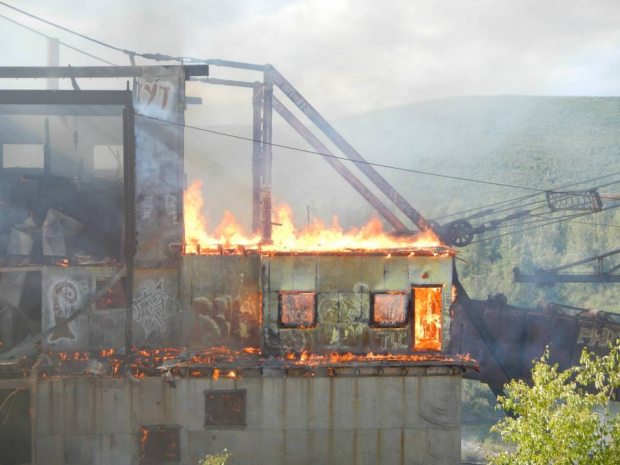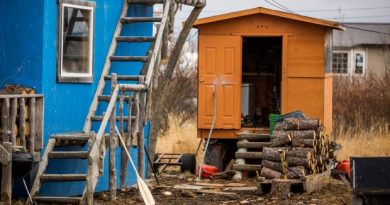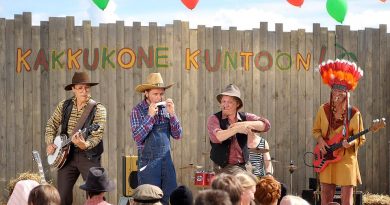Historic Alaska gold dredge goes up in smoke

(Courtesy Heather Moritz / Alaska Dispatch)
The historic Gold Dredge No. 3 north of Fairbanks went up in flames on Saturday afternoon and found no firefighters coming to its aid, as the fire fell outside of both the jurisdiction of local fire service departments and the Alaska Division of Forestry, which had initially mobilized its crews to fight the blaze but wound up fighting another fire spotted just down the road.
As first reported by the Fairbanks Daily News Miner, the fire was called in on Saturday afternoon. Alaska Division of Forestry aircraft responded to the call, but upon arriving, the lead pilot spotted “a column of smoke of equal concern,” farther down the road, Alaska Division of Forestry spokesperson Jim Schwarber said.
Once crews reached the Chatanika dredge, they discerned that it was a structure fire, which falls outside of the agency’s training and scope of work. The crews assessed the fire, determined that it was not in danger of spreading to nearby forests, and quickly shifted their focus and resources about 30 miles up the road, to what is being called the Long Creek fire. With crews already mobilized, they were able to start dumping fire retardant and water on the blaze just minutes later, putting a damper on the fire considered to be in a “critical protection area” due to nearby homes.
The Chatanika Gold Dredge No. 3, which sits out of the Fairbanks North Star Borough fire service protection area, was left to burn.
No fire service
The fire was reportedly started by two men in their 20s. Shirley Franklin, owner of the Chatanika Lodge down the Steese Highway, said that the two men came into the lodge, asking for buckets of water and saying they had started a fire at the dredge.
The two men “said that they were touching some kind of pulley over there, and it started to spark and they tried to get it out with a bottle of water,” Franklin said.
“By the time they got here it was out of control,” she continued. Her cook went to the site with buckets of water, and by the time he returned “the kids were already gone.” She said both men were Caucasian; one had blond hair and she heard there were two women with them.
Jane Haigh, co-owner of Gold Dredge No. 3, was dismayed by reports that someone had started the fire accidentally. She said that in the years she has owned the dredge, she never touched any of the equipment on site. “Not touching things would have been a good idea,” she said. “You think people would have enough sense not to do that.”
Matt Bach, one of the owners of the nearby Chatanika Gold Camp, said that he saw the dredge burning. He doesn’t think his business will be affected by the loss, but that “it’s a total shame.”
Gold Dredge No. 3 sits in the Chatanika area north of Fairbanks, outside of the borough fire service area. Franklin said that should the Chatanika Lodge burn, her business would also be left unprotected by fire fighters.
Lion Walker, a firefighter with the Steese Volunteer Fire Department, said his crew will only respond to fires outside of their designated area if there is a “life safety issue” — if someone is trapped in the fire, for instance, or if they are called in by the borough’s emergency manager.
Up in smoke
Haigh said she and dredge co-owner Patricia Peirsol bought the site in 1997 with one purpose: Preservation.
Haigh is an Alaskan historian and a professor of history at Kenai Peninsula College. “We didn’t ever do anything to [the dredge],” she said. They were disinclined to turn it into a tourist attraction, such as Gold Dredge No. 8 in Fairbanks, whose owner offers on-site tours, gold panning and a gift shop.
Gold Dredge No. 3 was one of eight purchased in the Fairbanks area in 1924 by the U.S. Smelting, Refining and Mining Co., working through local subsidiary Fairbanks Exploration Co.
Haigh said the dredge was constructed on-site sometime in the 1930s, with materials shipped up via the newly-constructed Alaska Railroad. The dredge operated until 1942, when all dredges were shut down due to World War II, and were then kicked back into operation in 1946.
“Ours operated until 1962,” Haigh said. After that, it sat unused, and exchanged hands a few times before Haigh and Peirsol bought it in the 1997.
Historic gold dredge sites around the state are disappearing, Haigh said. Now hers is gone, too. The dredge was the only piece of historic property that she owned.
Co-owner Peirsol visited the wreckage on Sunday. “It’s a mess,” she said.
The supporting structure is still upright, as are the masts, but all the cables are languishing in surrounding water, the wooden parts are all burned and sheet metal is hanging off of the structure. The wreckage was still smoking on Sunday afternoon.
“Probably nobody can put a value” on the dredge itself, Peirsol said, but in terms of what it brings to the community, “I would rate [the value] as very high.”
She has begun receiving phone calls and emails from people who are “sorry for us, sorry for themselves, sorry for our community,” she said. The co-owners had liability insurance on the dredge, in case someone got hurt, didn’t have insurance on the dredge itself, so likely won’t be able to make a claim on the lost property.
Who will investigate the fire?
Division of Forestry can’t investigate the cause of the fire “because the dredge is actually a structure,” which Alaska State Forestry Prevention Officer Mike Goyette said puts the fire outside of the agency’s jurisdiction.
And since Gold Dredge No. 3 lies outside of the Fairbanks North Star Borough fire service area, local fire departments are likewise not tasked with investigating the cause of the blaze, Goyette said.
Alaska State Troopers said on Sunday that they had not heard that two individuals had allegedly accidentally caused the fire.
“It hadn’t previously been reported to us,” said spokesperson Beth Ipsen, who passed the information about the fire’s alleged cause to her superiors after speaking with Alaska Dispatch. “We’re definitely going to make some inquiries about it.”
Another fire blazes
Meanwhile, 35 miles up the Steese Highway, the Long Creek fire is still burning. On Sunday afternoon, 58 people were working the fire, considered to be in a “critical area” due to homes located from between a quarter mile and mile away from the blaze.
Schwarber said that the fire was estimated somewhere between 40 and 80 acres, a relatively small fire, but one of concern to the homeowners.
So far this year, the number of wildfires in Alaska has hit 561 fires — up from the yearly average of 427. However, the acreage burned is hovering below the average 1.4 million acres, at around 1.1 million acres thus far.
Schwarber also pointed out that acreages burned fluctuates greatly from year to year. “Our extremes are so big in Alaska,” that averages don’t usually tell the whole story. In 2004, for instance, 6 million acres of forest burned. In 2008, only around 103,000 acres went up in flames.
This year is unusual, however, in that “usually we’re not in fire season this late,” as autumn approaches, Schwarber said.
With record-breaking hot weather rolling over much of Alaska this summer, and vegetation that has been at extremely dry levels for week, “we’re lucky that more hasn’t burned,” Schwarber said.
Some of that credit is due “to the firefighters, the other to where the lightening has struck.”
Contact Laurel Andrews at laurel(at)alaskadispatch.com



